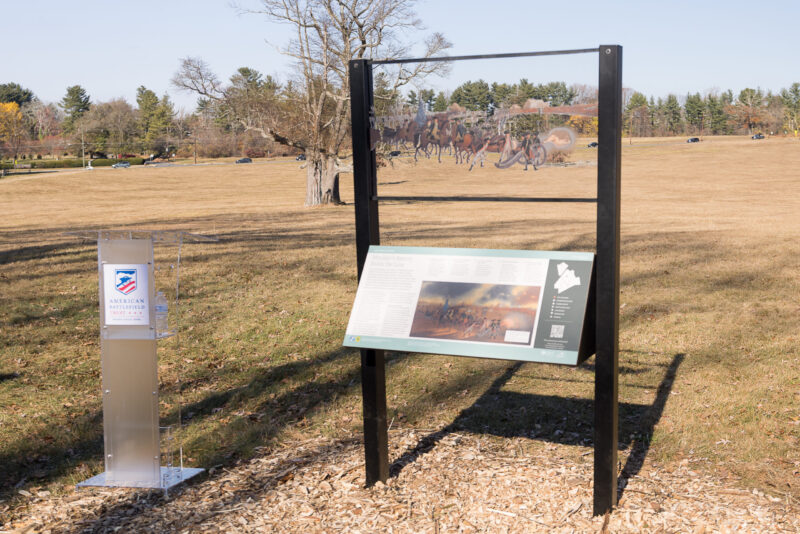“Battle Window” Unveiling Marks New Era, Upgrading Princeton Battlefield Experience
“BATTLE WINDOW”: The November 18 ceremony at Princeton Battlefield State Park was highlighted by the unveiling of a “battle window,” designed to help visitors better understand the Battle of Princeton. That interpretive device is just one of many enhancements preparing the Battlefield for the upcoming 250th anniversary of the American Revolution. (Photo by Dan Komoda)
By Donald Gilpin
In a ceremony at Princeton Battlefield State Park on Monday, November 18, a gathering of about 50 heard how new tourist-friendly historical signage and other upgrades will be providing future visitors with a better understanding of the Battle of Princeton, which was a decisive moment in American history and has been called the battle “that saved the American Revolution.”
The event was highlighted by the unveiling of a “battle window,” an interpretive sign that includes elements from a James Peale painting applied onto a clear acrylic window so that viewers can peer through to gain a sense of the battle action that took place on the landscape.
In preparing Princeton for America’s 250th anniversary celebration in 2026, and the 250th anniversary of the Battle of Princeton on January 3, 2027, there will be 13 new interpretive markers that will include a bronze patina battlefield map table, two “battle window” signs, and 10 interpretive plaques. The New Jersey
State Parks, Forests, and Historic Sites; the American Battlefield Trust (ABT); and the Princeton Battlefield Society have been the principal collaborators on the project.
New Jersey State Parks Assistant Commissioner John Cecil cited the Battle of Princeton as a turning point in American history. “On January 3, 1777, the cause of American independence hung in the balance at Princeton, and that pivotal moment in history deserves to be captured through the very best in 21st century interpretive techniques,” he said. “This new signage will immediately enhance the experience of visitors and excite the community for the work still in progress.”
In his comments to the assembled gathering Cecil added that the interpretive signs were intended to be user friendly and accessible, and also “to ignite the visitor’s imagination.”
He noted, “The goal in developing these materials has been to foster a meaningful and inclusive atmosphere for all visitors to Princeton Battlefield State Park. These new wayside exhibits aim to tell a comprehensive story of the battle, bringing to life the untold stories of all of those who were involved here on that dramatic day.”
PBS President Ben Strong praised the contributions of all the participating organizations as “the culmination of a lot of hard work, planning, and endless discussion.” He noted that the new signage can tell the whole story of the Battle of Princeton, “a huge, moving, violent drama.” He continued, “The hinge of history swings here on this battlefield.”
Strong went on to point out that the American victory at Princeton forced the British to pull out of New Jersey and eventually led to independence. “This is a critical spot,” he said. “It is sacred ground because American valor and blood spilled here behind you and all around you. We hope to walk around today and look at these new signs to get a better understanding of what happened here and to gain an appreciation for the sacrifice and courage that was shown here.”
He added that the upgrades and the collaborative Washington’s Legacy Plan would “turn New Jersey into a must-see Revolutionary War site, bringing the Revolutionary War into the 21st century here with the signage and the rehabilitation of this battlefield.”
The fiscal year 2025 New Jersey state budget announced in June includes $1.3 million for improvements to the Princeton Battlefield, and those funds, to be matched with private dollars raised by the American Battlefield Trust, the Princeton Battlefield Society, and others, will contribute to the relocation of parking outside the historic core of the battlefield where the most intense fighting took place, as well as a new park entrance, a visitor orientation circle, and 65 parking spaces with school bus access. Also planned are a walking path, restoration of historic tree and fence lines, and the recapture of period road traces.
Will Krakower, resource interpretive specialist at the park, described what this all means. “Visitors will get to walk the same pathways that Washington and his men took 250 years ago,” he said. “They’ll get to survey the grounds and see in their mind’s eye what it would have been like to witness hundreds of British troops on the hill opposite them. They’ll march over the same ground, stand on battle lines, charge through the recreated apple orchard — it’s going to be an amazing experience.”
Preservation architect Glenn Stach, who has been working with the American Battlefield Trust for more than eight years, spoke to the gathering about the significance of the Princeton Battlefield. “We think these places matter, and we know that you believe that as well. They matter in history, and they matter today, and they matter for future generations.”
He continued, “The way this battlefield is treated and is experienced, we believe matters. And your gathering here matters on the momentous occasion of embarking on a new era of experiencing this landscape.”


